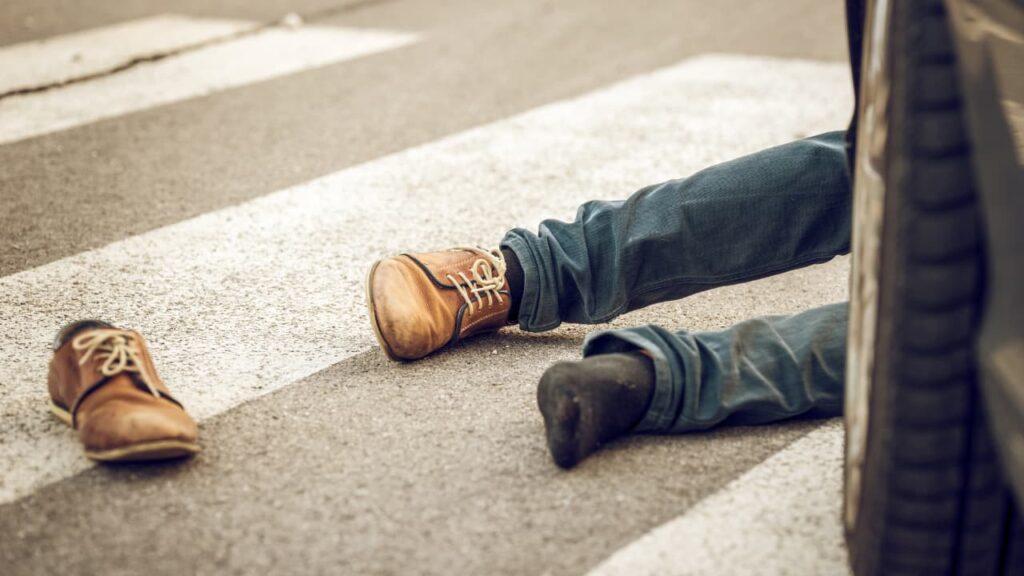Any kind of car accident can be traumatic. However, when a motor vehicle hits a pedestrian, the results can be catastrophic. You probably assume that any driver who hits and hurts a pedestrian is liable and negligent, right? While this is mostly true with Indiana pedestrian accidents, it’s not entirely true.
Knowing your rights is crucial if you’ve been injured in a pedestrian accident. While you may think you have a cut-and-dry claim, insurance companies, and sometimes even Indiana law, may think differently. It’s always best to consult a pedestrian accident lawyer to protect yourself.

Understanding Fault and Pedestrian Accidents
In today’s world full of phones and tablets, distracted driving is an unfortunate but common practice. All it takes is a split second for a driver to reach for their phone to respond to a text for an accident to occur. Pedestrians are often the victims of careless, distracted driving.
No matter how obvious the cause of a pedestrian accident is, the victim still has the burden of proving it. However, to prove liability and neglect, there are two things to consider: under the eyes of the law, a pedestrian accident is a two-way street.
Duty of Care
- Drivers: Motor vehicle operators have a legal duty to operate their vehicles safely, obey all traffic laws, and exercise caution not to harm pedestrians or other motorists.
- Pedestrians: Pedestrians must adhere to all traffic rules, use designated crosswalks, and avoid putting themselves in danger.
Breach of Duty
- Drivers: Running a red light or a stop sign, distracted driving, or not yielding to pedestrians in crosswalks are all examples of a driver breaching their duty of care.
- Pedestrians: Examples of pedestrians breaching their duty of care include crossing the street against traffic signals or crossing where it’s not permitted.

To prove liability in a pedestrian accident, the victim must show that the driver’s breach of duty caused the accident and that the victim suffered damages. This breach means the accident wouldn’t have occurred if the driver had followed their legal duty to operate their vehicle safely. An Indianapolis personal injury lawyer can help gather evidence and build a strong case to establish liability and secure the compensation the victim deserves.
If the accident victim can prove the incident wasn’t their fault, they have the right to seek compensation for damages. Plaintiffs can seek to recover damages for medical bills, loss of income, and even, in some cases, for non-economic losses like pain and suffering.
Modified Comparative Fault and Pedestrian Accidents
While not common with pedestrian accidents, the 51% Bar Rule could come into play. Indiana follows a modified comparative fault rule, which states that if the victim of an accident is 50% or less responsible for the accident, they can still claim damages. However, the damages will be reduced by the percentage of their responsibility.
For instance, if it’s been determined that a pedestrian was 20% responsible for the accident, they can still seek compensation but will only receive 70% of recovered damages if they win their case. An example of a pedestrian being partially at fault could be if a driver were speeding, but the pedestrian was jaywalking.
Is Jaywalking Illegal in Indiana?
While most Hoosiers know that jaywalking is unsafe, many don’t know that it’s illegal. There are several laws regarding pedestrians crossing the street. A passing police car probably won’t issue you a ticket if you cross the street in an area not designated for crossing, but it is a much bigger issue if you are struck by a car while doing so.
Since the state of Indiana does follow modified comparative fault, illegal jaywalking could play a huge role in your lawsuit. If you are 51% or more responsible for the accident and you were jaywalking, you won’t be able to seek compensation in any way.
Do Pedestrians Always Have the Right of Way in Indiana?
You may think that pedestrians always have the right of way, no matter the circumstance. Most motorists will yield to pedestrians as if they have the right of way, but this is more a matter of safety than who’s right. Pedestrians have the right of way when:
- They cross within marked crosswalks at intersections
- Crossing at unmarked intersections where the crosswalk is assumed to be
- Crossing at places with a traffic signal that displays “Walk”
- They are crossing at an intersection with a traffic light that is green for the direction they’re going
Pedestrians don’t have the right of way when:
- Crossing a public road at points that aren’t designated for crossing
- Disobeying traffic signals (Crossing when the light is red or displays “Don’t Walk”)
- Crossing a street in a diagonal direction
Indiana Code § 9-21-17-5 states that pedestrians may not suddenly leave the safety of the sidewalk and onto the street where it could put them in danger.

Pedestrian Accidents and Your Rights
As is common with all personal injury lawsuits, pedestrian accident victims have the legal right to seek compensation for damages. They will, however, have the burden of proving negligence and damages. In Indiana, you can seek both economic and non-economic damages. Economic damages can include:
- Medical bills
- Loss of current and future income
- Transportation costs to and from medical appointments
- Costs of OTC medications and medical devices
- Any costs associated with home modifications related to the injury
- The costs of housekeeping or lawn maintenance if unable to do so
Non-economic damages can include:
- Pain and suffering
- Loss of consortium
- Loss of enjoyment of life
- Emotional trauma
- Scarring and disfigurement
In rare cases, a pedestrian accident victim may be entitled to punitive damages. These may be awarded if the driver acted recklessly or intentionally. Punitive damages are intended to punish and deter the driver from acting in the same manner in the future. The state of Indiana does have limits and caps on these penalties.
Pedestrian Accident Liability in Indiana: What You Need to Know
Being struck by a motor vehicle as a pedestrian can be a life-altering and traumatic experience, often leaving victims with a long road to recovery. As long as the pedestrian was 50% or less responsible for the accident, they can seek to recover damages.
If you’ve been hit by a vehicle, it’s important to have an experienced personal injury attorney who will fight for your right to fair compensation. Don’t naively accept an insurance company’s settlement offer without first speaking to a pedestrian accident lawyer. Navigating the sometimes complex process without the guidance of a legal professional isn’t in your best interest.
Yosha Law is committed to ensuring you receive the best possible outcome while also pursuing accountability. Contact one of our compassionate attorneys today.
-min.png)
-min.png)